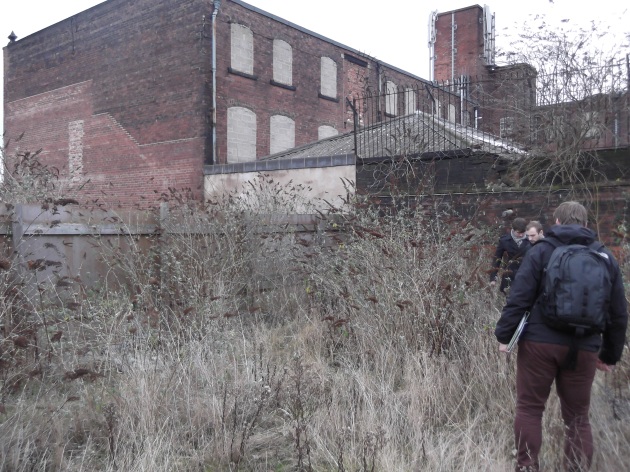Making Common Ground at Furnace Park: place, purpose and familiarisation
September 24, 2016 1 Comment

I’ve been increasingly exploring the stabilities of place. In recent years writers on place have tended to emphasise place’s flux: the way in which it is a momentary, fragile assemblage of the varied intentions, actions and desires of those who happen to be present in (or otherwise having influence over) any seemingly coherent action-space. I get this kick against formalism, but I think that it tends to present place as too fluid. My recent projects have been examining various ways by which places become stabilised (and replicated). My recent article (details here) on the role of law in shaping the form and proliferation of the ‘classic’ cotton mill published in Geoforum earlier this year is an early outing on this. And now – after three years of gestation, my article co-written with Amanda Crawley Jackson of the University of Sheffield has been published in Social and Cultural Geography. At the end of 2012 I was invited to observe the site assembly process for the experimental Furnace Park project, and specifically to think about how the project came together in that first phase – how ‘common ground’ came about both amongst the diverse range of stakeholders (all with their own orientation on what this prospective place would be) and also how those (human) protagonists made common ground with the ground itself. Amanda and I then set out to write our joint paper, and to find our own disciplinary common ground (and once we’d found it, then reconcile it with the differing views of our article’s peer reviewers and editors). In due course our text – and its various iterations – took on much of the machinations of the place-making and its pressures towards attunement and accommodation.
Our article is available to view here for free (for the first 50 uses of this link). I’m not going to re-write the article here, but here’s the abstract as a taster, which explains that it was written as part of a special issue on the ‘geographies of strangers and strange encounters’:
“In this article we seek to widen the debate about the sites and processes of encounter with strangers by examining the ways in which ‘strangeness’ necessarily fades within the familiarisation processes at play in any sustained and situated place-making. Our analysis draws upon our experiences of encountering strangers – and of our familiarisation with them – in the initial, year-long, site acquisition and preparation phase of a project to create Furnace Park, an experimental urban space in a run-down backwater of central Sheffield. We show the tensions between a project commitment to the formation of a loose, open place and the pressures (which arose from our encounters with the urban development system) to render both the project and the site certain, bounded and less-than-strange. Furthermore, at Furnace Park the site itself presented to us as a non-human stranger, which we were urged to render familiar but which kept eluding that capture. We therefore show how the geographies of strange encounters could productively be widened to embrace both recent scholarship on the material-affective strangeness of ground itself, and a greater attentiveness to the familiarisation effects born of the intersection of diverse communities of practices within place-making projects.”
The first iteration of our joint paper was presented at the ‘geographies of strangers’ session at the 2013 Royal Geographical Society Annual Conference, and we were subsequently invited aboard this special issue project. I think we are the only article that regards ground itself as a stranger, which considers place-making (and in particular professional interactions) as anything to do with strangers, and which emphasises that strangeness (and familiarity) are both unstable, perhaps necessarily so in place-making.
Our claim to novelty is perhaps also captured in the following paragraph (taken from our article):
“Our aim in this article is to present a case study examination of how the unknown – or strange to us – was encountered and how it was familiarised within our place-making endeavours. Our article broadens the place-making-by-encounter-and-familiarisation scholarship in three ways: first by being an ‘insider’ account – a reflexive examination by us as academics implicated in the making of a place; secondly, by our concern to focus not upon the transformative (or otherwise) effects of human to human encounter, but instead upon our human encounters with the unknown materiality of the case study site, thus figuring the site itself as a stranger; thirdly, by our concern to show the directive, shaping role of pre-existing cultural expectations brought to our site, and our project, by the myriad (human) stakeholders who needed to come together to make the project happen. Here we seek to show how these expectations drove forward an attempted (but never fully realised) elimination of the unknown and of how a restless surplus of strangeness remained.”
Amanda is the director of the Furnace Park. It is now an up-and-running project, with details of the site’s many past and future events, alongside Amanda’s wider projects with the occursus collective showcased here. My involvement ended after site assembly, but the insights from working on this paper have certainly influenced my subsequent projects, such as the prospective St Peter’s, Kilmahew stabilisation project (details here) and work that I’m currently doing on the peculiarities of contingent places (yes, that’s more bunkers).

Reblogged this on occursus.